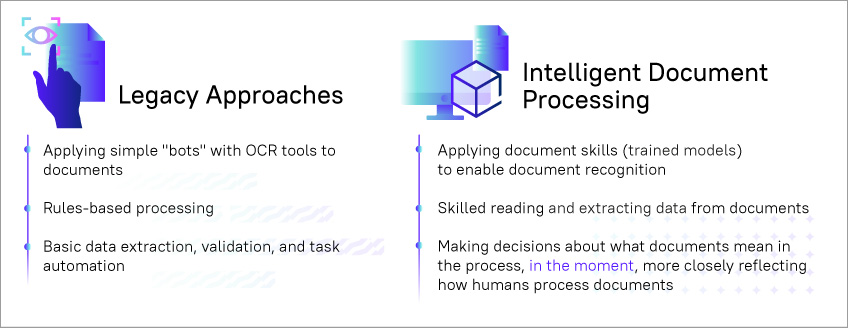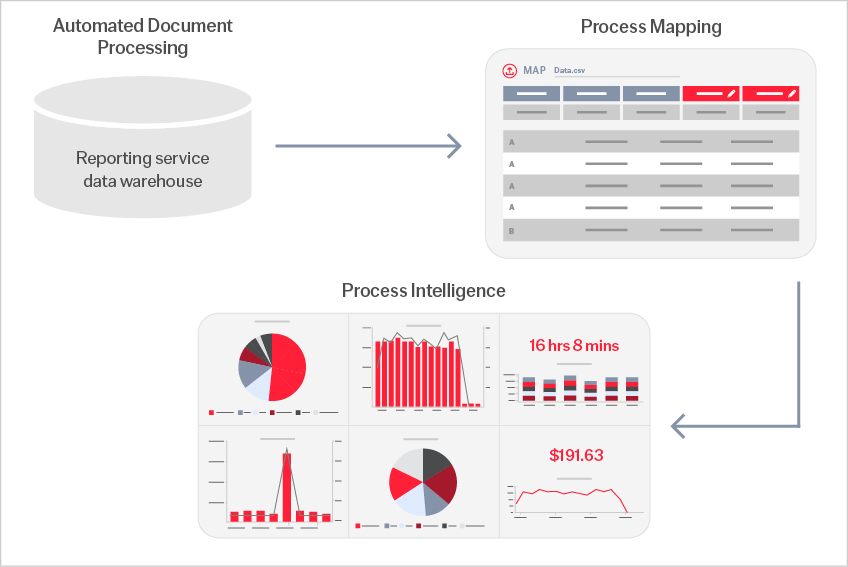
Cookiebot-Driven Success: Optimizing Your Website's Visibility

Cookiebot-Driven Success: Optimizing Your Website’s Visibility
What Is Intelligent Document Processing, and How Does It Work?
Maxime Vermeir
August 28, 2023

While it may sound thoroughly modern (and it is), intelligent document processing finds its earliest roots in the development of the first optical character recognition (OCR) solutions, which did little more than convert character images into machine-encoded text. Now, intelligent document processing has artificial-intelligence-based capabilities that enable processing of all types of data from any kind of document—structured, semi-structured, or unstructured—for just about any process in any industry. This blog explores your most frequently asked questions about intelligent document processing, including how it works and use case examples, to provide insights on how you can leverage IDP to transform your business.
Jump to:
What is intelligent document processing (IDP)?
What IDP is not
The evolution of IDP
How it works
Benefits
Use cases
How to choose the right IDP software
Frequently asked questions
What is intelligent document processing (IDP)?
Intelligent document processing (IDP) applies artificial intelligence (AI) and machine learning techniques to process structured, semi-structured, and unstructured documents that enable technology to read and process content in documents like a human.
Over the years, technology evolved to incorporate more intelligent capabilities, such as natural language processing (NLP). This allowed document processing to advance beyond simple character recognition and enabled some level of comprehension of the text being converted. In spite of these advancements, for years IDP remained a siloed mailroom or BPO function, isolated from revenue-critical engagements with customers, suppliers, and employees.
Today, this legacy approach is giving way to modern intelligent document processing. While earlier solutions focused primarily on text and field data extraction, IDP encompasses the processes in which content is used as part of customer and employee experiences. It begins with a re-thinking of these processes, then targets modern, AI-based document processing “skills” to make the content immediately available and actionable exactly when and where it’s needed.
Learn more about ABBYY’s low-code / no-code IDP solution
What IDP is not
In understanding what IDP is and how it benefits businesses, it’s equally important to understand what it is not:
- IDP is not just OCR or data capture. While IDP incorporates OCR and data capture technology, these are part of a larger set of capabilities that add more expert skill and decision-making to the processing of content.
- IDP is not robotic process automation (RPA). RPA is discrete task automation within defined processes that runs on data. Since content is a source of this data, it’s essential to understand the content in context before data can be extracted from it for various downstream processes. Robotic process automation cannot do this on its own and thus requires support from IDP to make skilled decisions on content.
- IDP is not the same thing as ChatGPT. Many people think ChatGPT is the same thing as optical character recognition (OCR), but it is not; in reality, it is a natural language processing (NLP) model that uses deep learning algorithms to generate human-like text responses to user queries. ABBYY Vantage, on the other hand, is an IDP solution that uses optical character recognition (OCR) technology to extract data from various types of documents, including invoices , purchase orders, contracts, and more.
The evolution of IDP

How does intelligent document processing work?
IDP uses natural language processing (NLP) techniques and contextual data in the surrounding text for entity extraction that automatically and with a high degree of accuracy determines which entities are being referred to. For example, is the word “jaguar” referring to a large cat or a car? OR is the word ‘Sue’ referring to a person or a legal action? By applying NLP, an unprecedented recognition of unstructured data is identified and extracted, and can operate like a human brain, quickly adapting to changing input, and generating the best possible result.

With FastML , a new client-side learning mechanism, visual and textual methods of extraction are applied, thus enabling even greater accuracy of data extraction. Organizations that are looking to maintain competitive advantage can do so by shifting away the cumbersome, transactional, and high-volume content-driven workload to intelligent document processing and intelligent automation solutions, thus freeing up time for human workers to be engaged in more rewarding work and drive better customer experiences.
What are the benefits of intelligent document processing?
Across all industries, businesses are facing pressure to do more—and do it faster—with fewer skilled resources. At the same time, more organizations are focusing on improving experiences for customers and employees as a key to improving revenue, margins, and retention. Intelligent document processing (IDP) can deliver significant benefits on both counts. By applying document skills in a way that closely supports the way humans understand and manage content, IDP provides the following benefits:
- Operational efficiency: Manual data extraction and entry can be time-consuming and expensive. IDP saves time/money while reducing the risk of costly errors.
- Compliance: IDP reduces the risk of human error which means businesses can be more compliant. Managing compliance tasks becomes easier as IDP bots leave a digital trail and logs can be used in an event of audit.
- Customer experience: With IDP, employees are freed from the tedious tasks of reading and manually processing documents, while customers enjoy greater efficiency in document-centric processes and decisions related to their account, claim, or case.
- Scalability: IDP is scalable and can expand cross function: IDP software can be trained to process one document type (for example: invoices) and process as little as 100 documents per day, or it can be trained to ingest one hundred different document types (invoices, claims, bank statement, onboarding, receipt, etc.) and process thousands of documents per minute.
How does combining process mining & IDP provide greater value?
Content does not exist in a vacuum—it’s an integral part of the business processes that fuel the day-to-day work of organizations across industries. Because of content’s role in a much bigger picture of decision-making and customer experience, simply incorporating intelligent document processing into legacy processes can yield at best limited results, mainly because the processes are not made for it. For IDP to be successful, therefore, it must be applied to optimized digital processes, and this is where process mining comes into the picture.

Process mining helps businesses mine their processes to make smart decisions about where to automate document processing. It extracts timestamp data from information systems and applies AI to build a visual model of the process from start to finish, including all deviations. Process owners become able to clearly see how content flows through the process, gaining the insights they need to identify and address inefficiencies that could hamper the success of IDP implementation.
As the basis for successful automation, process mining works in conjunction with IDP to enable businesses to:
- Understand the process and how content enables it;
- Gain insight into how content acts as the basis for skilled decision-making within the process;
- Determine how they should handle content to make the process work better; and
- Apply the document skills needed to optimize content processing.
IDP use cases: Digitally master your data and processes
The versatility of intelligent document processing applications means documents of any language, any format and at any time can be utilized in intelligent automation solutions. We’ll explore four use cases in insurance, customer onboarding/KYC, logistics, loan processing to show examples of how IDP can be leveraged.
IDP in Insurance
Intelligent document processing in insurance can be used in a variety of ways. For example, for automated decisioning such as “hands-free claims”; to provide smart digital self-service options that can answer questions usually handled by a call center; and for digital process automation liberating employees from mundane tasks to instead focus on empathy and better customer experience.
Leveraging ABBYY’s intelligent document processing solution, multinational insurance broker Ecclesia Group digitized and streamlined correspondence management, thereby providing a better customer experience. ABBYY IDP extracts critical data from scanned claims documents, including case numbers and license plates; correctly matches documents with the related entry in the customer database; and then automatically routes the document to the appropriate claims’ manager for further processing.
IDP in Customer Loan Processing
Mortgage applications are a prime example of document overload with a typical loan folder comprising 100-200 pages. Information required can include driving license, birth certificates, proof of address, utility bills, bank statements and pay slips. Intelligent document processing can streamline the whole process by automatically capturing, reading, understanding, and validating the information within each document to verify the data is correct and genuine so the loan can be authorized for approval faster. The whole process can be managed online and via mobile for improved and more convenient customer experience.
Even better is IDP’s ability to scale, with loan applications often surging during economic downturn. During the pandemic, banks in Spain needed to process a staggering twenty million pages of documents from customers asking for loans—with peaks of more than 100,000 a day. With the help of ABBYY’s intelligent document processing technology it was all done in less than six weeks during lockdown. Serimag, a leading process automation company for the banking industry in Spain, leveraged ABBYY’s IDP platform, enabling them to extract text quickly and accurately from millions of loan applications—resulting in 75 percent automation of the whole process and supporting Serimag’s efforts to ensure SLA accuracy of more than 99 percent in their results.
IDP in Customer Onboarding/KYC
When IDP is used for customer onboarding and know-your-customer (KYC) compliance, financial services can improve customer experience, increase efficiency, drive revenue, and reduce costs.
Serimag integrated ABBYY’s industry leading IDP technology into their intelligent document processing (IDP) service for banks in Spain to manage complex support documents in the loan application process to alleviate the impact of COVID-19. ABBYY’s IDP capabilities delivered the expected results in this critical project during turbulent times, achieving more than 75 percent automation of the whole process.
IDP in Logistics
Mistakes in paperwork can stop a shipment in its tracks and lead to major delays in the delivery of essential goods. Intelligent document processing brings accuracy and operational efficiency by automatically handling a whole host of shipping documents such as customs declaration forms, delivery receipts, bills of lading and driver logs.
Global logistics company Deutsche Post DHL Group delivers parcels and express mail across borders around the world and saw outstanding results by automating its finance department.
The company, which generated $100 billion USD in 2022, previously had a highly manual accounts system for processing hundreds of thousands of invoices annually. By introducing ABBYY’s intelligent document processing, the company was able to automatically process invoices from 124 vendors in different languages—reducing errors and increasing productivity. The company then rolled out the IDP automation project to other departments to benefit from an incredible 70 percent increase in efficiency.
How to choose the right intelligent document processing software
With so much hype around artificial intelligence and a forever evolving technology landscape, choosing the right intelligent document processing software is a vital decision for ensuring you are on the right track for optimal digital transformation of business processes. Here are a few crucial points to consider.
- 1. Assess the precise needs of your business.
A one-size fits all approach never works, so you must think clearly about specific requirements. What exactly are you trying to achieve? Better customer experience, productivity improvements, touchless straight-through processing, reducing employee burnout? The definite goals of investment in IDP must be outlined from the start to be sure you will choose the right platform at the right price to achieve good ROI. Be ready with detailed questions for your prospective vendor in terms of projected outcomes, increased productivity, ease of integration, user adaptation, scalability, employee training, as well as security and compliance, especially with the introduction of new laws on ethical AI. - 2. Determine what data you need to process.
Depending on your industry, the type of data and documents you need to process will vary. It might be claims processing in insurance, legal documents for law firms, loan applications for banks or contract management for commercial real estate agents. Intelligent document processing can be customized and trained to handle different document types. The data needed may be structured, such as information on standard forms and tables, or corresponding fields in a company database or software platform. However, you may also need to process unstructured data, such as copy within emails, text messages or graphics, some of which may be highly confidential. It’s therefore crucial to know exactly where, and what type of data you are working with before choosing your IDP platform. - 3. Look for a solution that meets your requirements.
Once you have assessed your specific needs it will be easier to find a solution to meet your requirements. For example, you may have data in different languages that will need to be translated before being analyzed or forwarded to another system. There may be strict privacy guidelines about using the data so authentication and validation features in your IDP software platform will be a top priority. Data classification and integration is also an important factor for automatic transfer into existing workflows. IDP can categorize documents into predefined classes helping to organize and prioritize workload, for example sorting applications in date order or emails into different folders, depending on their content.
The future of document processing
Intelligent document processing offers businesses a host of bottom-line advantages—if it’s implemented strategically as an essential participant in customer experience, and processes are built for it. By first leveraging process mining and creating a solid foundation for implementation, organizations can realize the full benefits of IDP, including reduced costs and improved efficiency, regulatory compliance, and employee and customer experiences.
ABBYY’s market-leading technologies, delivered in a low-code / no-code approach, power ABBYY Vantage , the new intelligent document processing platform for the digital workforce.
Over the years, we at ABBYY have learned that customers would really like to have pre-trained skills that are ready-to-go and that they can immediately leverage. That is why we introduced ABBYY Marketplace , an online digital community where customers can download skills and other technology assets that add value to ABBYY’s intelligent document processing platform.
With Vantage , the ability to train and create your document skill models means you don’t have to be an OCR or machine learning expert. Human interaction during review feeds online learning to improve your models. And the key to scaling the solution and applying the technology across many business areas is allowing it to adapt to the different document types and variations.
Ready to accelerate digital transformation and change the way you automate document processes?
Frequently asked questions
What’s the difference between IDP and OCR?
OCR has been around for a long time and is seen more as a data capture-related technology. It is primarily used to extract text from paper documents, scanned images or photographs and converts them into text that can be edited digitally on a computer. The technology is commonly used to digitize printed documents to make them accessible electronically, for example on a web page.
However, OCR does not understand the meaning of the text, it just focusses on recognition of the characters. IDP, on the other hand, incorporates a broader range of capabilities. It not only uses OCR for character recognition but incorporates artificial intelligence and machine learning to read and understand what the text means and thus be able to use it to make decisions on its value and know and what to do with it. For example, it may read an invoice, take its content to be compared to a corresponding purchase order, compare the sums for accuracy, and then forward it to the right person for payment.
What’s the difference between intelligent document processing and automated document processing?
Put simply, ADP is far less clever than IDP. ADP can handle routine and repetitive tasks associated with documents, such as sorting them alphabetically, extracting, and validating information. However, it typically takes a rules-based approach and is best with structured documents that have the same layout. That means it may struggle with unstructured or semi-structured documents where the content varies, and the design is different. It can’t adapt and learn from previous content is has come across.
With intelligent document processing, it uses AI and machine learning to handle a far wider selection of document complexities. It basically has added cognitive skills to think like a human. IDP can learn and adapt to different layouts, structures and content in documents and adjust accordingly. If it comes across a nuance, it will understand what to do, and learn from any mistakes. This makes it ideal for processing any unstructured data or when there is no pattern to be followed, thus making it ideal for businesses dealing with diverse and evolving document types.
What are the benefits of combining IDP with RPA?
RPA is a legacy software for automating repetitive and simple business processes. It is often referred to as the ‘swivel chair’ approach to automation as it can complete basic tasks like inputting data, capturing data, validating information, and making updates to documents. What RPA lacks is the brains to understand the information it is working with and put it into context. That’s where IDP comes in.
Intelligent document processing gives RPA the cognitive skills to make sense of the data it reads, which can unlock vital information for companies to make better business decisions. By combining the two you are adding human-like understanding to your automation process to create a more intelligent and efficient automation solution that drives operational excellence and business growth.
Working in tandem, the two technologies will provide enhanced accuracy of data extraction, increase straight through processing rates, reduce the need for human intervention, and free up staff for more meaningful revenue-generating tasks.
Who should use intelligent document processing?
Any organization that handles a substantial amount of data and documents will benefit from intelligent document processing. IDP can reduce manual, repetitive, and mundane work, improve accuracy, and enhance productivity. It’s estimated that 80-90% of business data is unstructured, and companies are losing out on potential income by not leveraging this information. IDP can make a huge difference in improving efficiency and revenue for every industry.
In banks, they can streamline loan applications, in healthcare IDP can manage patient records and insurance claims, in logistics, millions of dollars can be saved by taking away manual data entry for orders and deliveries, while in the government sector, IDP is speeding up the allocation of driving permits and social security payments. In fact, across all industries, accounts payable departments are benefiting from straight through processing rates of up to 90% with IDP, resulting in huge cost savings and freeing up employees for more meaningful work.
Editorial note: This blog post was originally published on December 8, 2021, and updated on August 28, 2023, to reflect a clarified definition of what is intelligent document processing, how it differs from generative AI models such as ChatGPT, and four modern IDP use cases that showcase our customer’s digital transformation journey.
Intelligent Document Processing (IDP) Intelligent Automation Digital Transformation Robotic Process Automation (RPA)

Maxime Vermeir
Senior Director of AI Strategy
With a decade of experience in product and technology, Maxime Vermeir is an entrepreneurial professional with a passion for creating exceptional customer experiences. As a leader, he has managed global teams of innovation consultants and led large enterprises’ transformation initiatives. Creating insights into new technologies and how they can drive higher customer value is a key point in Maxime’s array of Subject Matter Expertise. He is a trusted advisor and thought leader in his field, guiding market awareness for ABBYY’s technologies.
Connect with Max on LinkedIn .
Like, share or repost
Share
Subscribe for blog updates
First name*
E-mail*
Сountry*
СountryAfghanistanAland IslandsAlbaniaAlgeriaAmerican SamoaAndorraAngolaAnguillaAntarcticaAntigua and BarbudaArgentinaArmeniaArubaAustraliaAustriaAzerbaijanBahamasBahrainBangladeshBarbadosBelgiumBelizeBeninBermudaBhutanBoliviaBonaire, Sint Eustatius and SabaBosnia and HerzegovinaBotswanaBouvet IslandBrazilBritish Indian Ocean TerritoryBritish Virgin IslandsBrunei DarussalamBulgariaBurkina FasoBurundiCambodiaCameroonCanadaCape VerdeCayman IslandsCentral African RepublicChadChileChinaChristmas IslandCocos (Keeling) IslandsColombiaComorosCongo (Brazzaville)Congo, (Kinshasa)Cook IslandsCosta RicaCroatiaCuraçaoCyprusCzech RepublicCôte d’IvoireDenmarkDjiboutiDominicaDominican RepublicEcuadorEgyptEl SalvadorEquatorial GuineaEritreaEstoniaEthiopiaFalkland Islands (Malvinas)Faroe IslandsFijiFinlandFranceFrench GuianaFrench PolynesiaFrench Southern TerritoriesGabonGambiaGeorgiaGermanyGhanaGibraltarGreeceGreenlandGrenadaGuadeloupeGuamGuatemalaGuernseyGuineaGuinea-BissauGuyanaHaitiHeard and Mcdonald IslandsHoly See (Vatican City State)HondurasHong Kong, SAR ChinaHungaryIcelandIndiaIndonesiaIraqIrelandIsle of ManIsraelITJamaicaJapanJerseyJordanKazakhstanKenyaKiribatiKorea (South)KuwaitKyrgyzstanLao PDRLatviaLebanonLesothoLiberiaLibyaLiechtensteinLithuaniaLuxembourgMacao, SAR ChinaMacedonia, Republic ofMadagascarMalawiMalaysiaMaldivesMaliMaltaMarshall IslandsMartiniqueMauritaniaMauritiusMayotteMexicoMicronesia, Federated States ofMoldovaMonacoMongoliaMontenegroMontserratMoroccoMozambiqueMyanmarNamibiaNauruNepalNetherlandsNetherlands AntillesNew CaledoniaNew ZealandNicaraguaNigerNigeriaNiueNorfolk IslandNorthern Mariana IslandsNorwayOmanPakistanPalauPalestinian TerritoryPanamaPapua New GuineaParaguayPeruPhilippinesPitcairnPolandPortugalPuerto RicoQatarRomaniaRwandaRéunionSaint HelenaSaint Kitts and NevisSaint LuciaSaint Pierre and MiquelonSaint Vincent and GrenadinesSaint-BarthélemySaint-Martin (French part)SamoaSan MarinoSao Tome and PrincipeSaudi ArabiaSenegalSerbiaSeychellesSierra LeoneSingaporeSint Maarten (Dutch part)SlovakiaSloveniaSolomon IslandsSouth AfricaSouth Georgia and the South Sandwich IslandsSouth SudanSpainSri LankaSurinameSvalbard and Jan Mayen IslandsSwazilandSwedenSwitzerlandTaiwan, Republic of ChinaTajikistanTanzania, United Republic ofThailandTimor-LesteTogoTokelauTongaTrinidad and TobagoTunisiaTurkeyTurks and Caicos IslandsTuvaluUgandaUkraineUnited Arab EmiratesUnited KingdomUnited States of AmericaUruguayUS Minor Outlying IslandsUzbekistanVanuatuVenezuela (Bolivarian Republic)Viet NamVirgin Islands, USWallis and Futuna IslandsWestern SaharaZambiaZimbabwe
I have read and agree with the Privacy policy and the Cookie policy .
I agree to receive email updates from ABBYY Solutions Ltd. such as news related to ABBYY Solutions Ltd. products and technologies, invitations to events and webinars, and information about whitepapers and content related to ABBYY Solutions Ltd. products and services.
I am aware that my consent could be revoked at any time by clicking the unsubscribe link inside any email received from ABBYY Solutions Ltd. or via ABBYY Data Subject Access Rights Form .
Referrer
Last name
Query string
Product Interest Temp
UTM Campaign Name
UTM Medium
UTM Source
ITM Source
GA Client ID
UTM Content
GDPR Consent Note
Captcha Score
Page URL
Connect with us
Also read:
- [New] In 2024, Protecting Posts Copyright Verification for TikTokers
- [Updated] 2024 Approved Exploring Dynamic Images in iPhone Applications
- [Updated] In 2024, Rhythms Unlocked FB Downloads Galore
- [Updated] Precision in Screen Recording A Comprehensively Reviewed List for 2024
- Converting Vimeo Selections The Pathway to Memorable GIFs
- Exclusive Dive Into the 2024 FB Ad Landscape
- Exclusive Lucyd Lyte Eyewear Analysis: Unveiling the Connection Between Stylish Sunglasses and AI Limitations
- Expert Analysis of the Mophie Triple-Charging Station - A Perfect Companion for iPhone Users on the Go
- Exploring the New Era: The Ultimate Guide to Lenovo's Gen E ThinkPad X1 Nano - Where Portability Meets Powerful Processing.
- Full Rotation Video Gear for Social Media Broadcasts
- In-Depth Analysis of Beyerdynamic Blue BYRD 2 Active Noise Cancelling Headphones
- In-Depth Analysis of HyperX Cloud III Wireless Headset: Immersive Sound Experience & Exclusions for Xbox Gamers
- In-Depth Analysis of Raycon Everyday Pro Headphones: Impressive Endurance but Limited Functionality
- In-Depth Analysis of the Dell Inspiron 7635: Impressive Display Vs. Notable Issues Unveiled in Our Latest Review
- In-Depth Analysis: Maximizing Home Networking with Netgear's 6E Trio in the Nighthawk MK93S Mesh Router System
- In-Depth Evaluation of Oladeanse's OWS1 Earbuds: Impressive Aesthetics Meet Mixed Audio Quality
- Master System Administration: Streamline Your Tasks Using Windows PowerShell for Only $16 - Insights From ZDNet
- Sleuthing Out Stealthy Cyber Menaces on PCs
- Top 11 Free Online Platforms for Movie Downloads
- Title: Cookiebot-Driven Success: Optimizing Your Website's Visibility
- Author: Mark
- Created at : 2025-01-02 16:16:01
- Updated at : 2025-01-09 22:04:33
- Link: https://some-guidance.techidaily.com/cookiebot-driven-success-optimizing-your-websites-visibility/
- License: This work is licensed under CC BY-NC-SA 4.0.